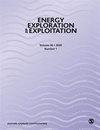鄂尔多斯盆地南部三叠系延长组致密油砂岩现今地应力的常规测井测定方法
IF 1.6
4区 工程技术
Q4 ENERGY & FUELS
引用次数: 0
摘要
当前的地应力影响着致密油砂岩的钻井设计、井网部署、完井改造、水力压裂和注水。由于昂贵的成本和有限的岩心样本,通常无法获得这些应力的测量数据,因此对于致密油砂岩,使用常规测井来确定这些应力是必要的。首先,根据鄂尔多斯盆地南部合水地区延长组六段(长6)的地质特征,选择了适合当前常规测井地应力计算的计算模型;然后,利用常规测井曲线确定岩石动态力学参数,并用三轴岩石力学试验得到的岩石静态力学参数进行校正。采用经验公式法确定孔隙流体压力。最后,根据所选择的应力模型,分别计算了6口井的最大、最小水平压应力(σH、σH)和垂直应力(σv)。本文方法计算的现今地应力与声发射试验和有限元数值模拟结果相吻合,相对误差小于10%。结果表明:研究区内的σH、σH和水平差应力(σH−h)震级分别为32 ~ 43 MPa、23 ~ 37 MPa和5 ~ 8 MPa;现今三维地应力的大小随深度的增加而增大。σH、σv和σH的平均梯度分别为0.018、0.014和0.015 MPa/m,即σH>σv> σH。在此应力状态下,研究区水力裂缝一般以与σH方向相交的小角度发育,具有向多个方向扩展的趋势。本文章由计算机程序翻译,如有差异,请以英文原文为准。
Determining the present-day in-situ stresses of tight-oil sandstones by conventional logs: An approach in the Triassic Yanchang Formation, southern Ordos Basin
The present-day in-situ stresses affect the drilling design, well pattern deployment, well completion modification, hydraulic fracturing and water injection of tight-oil sandstones. The measurement data of these stresses are commonly unavailable because of their high costs and limited core samples, therefore employing conventional logs for these stress determination is imperative for tight-oil sandstones. Firstly, the suitable calculation models for the present-day in-situ stress calculation by conventional logs were selected according to the geological characteristics of the sixth member of the Yanchang Formation (Chang 6) in Heshui area of the southern Ordos Basin, China. Then, the dynamic rock mechanical parameters were determined by conventional logs, and corrected by the static rock mechanical parameters obtained from the triaxial rock mechanical tests. Moreover, the pore fluid pressure was determined by the empirical formula method. Finally, the maximum and minimum horizontal compressive stresses (σH and σh), and the vertical stress (σv) of six wells were calculated according to the selected models of these stresses, respectively. The present-day in-situ stresses, determined by the proposed method in the paper, were verified by those obtained from acoustic emission tests and finite-element numerical simulations with the relative errors of less than 10%. The results show that the magnitudes of σH, σh and the horizontal differential stress (σH−h) in the study area mainly range from 32 to 43 MPa, 23 to 37 MPa and 5 to 8 MPa, respectively. The magnitude of the three-dimensional present-day in-situ stress increases with the increase of depth. The average gradients of σH, σv and σh are 0.018, 0.014 and 0.015 MPa/m, respectively, that is σH>σv>σh. In this stress state, the hydraulic fractures, with a trend of little expansion towards multiple directions, are commonly developed at a small angle intersecting with the direction of σH in the study area.
求助全文
通过发布文献求助,成功后即可免费获取论文全文。
去求助
来源期刊

Energy Exploration & Exploitation
工程技术-能源与燃料
CiteScore
5.40
自引率
3.70%
发文量
78
审稿时长
3.9 months
期刊介绍:
Energy Exploration & Exploitation is a peer-reviewed, open access journal that provides up-to-date, informative reviews and original articles on important issues in the exploration, exploitation, use and economics of the world’s energy resources.
 求助内容:
求助内容: 应助结果提醒方式:
应助结果提醒方式:


